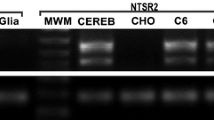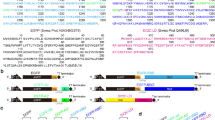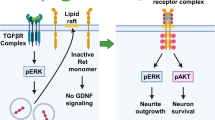Abstract
Neurons fail to re-extend their processes within the central nervous system environment in vivo, and this is partly because of inhibitory proteins expressed within myelin debris and reactive astrocytes that actively signal to the injured nerve cells to limit their growth. The ability of the trans-acting activator of transcription (TAT) protein transduction domain (PTD) to transport macromolecules across biological membranes raises the possibility of developing it as a therapeutic delivery tool for nerve regeneration. Most studies have produced TAT PTD fusion protein in bacteria, which can result in problems such as protein solubility, the formation of inclusion bodies and the lack of eukaryotic posttranslational modifications. While some groups have investigated the production of TAT PTD fusion protein in mammalian cells, these strategies are focused on generating TAT PTD fusions that are targeted to the secretory pathway, where furin protease as well as other proteases can cleave the TAT PTD. As an alternative to mutating the furin cleavage site in the TAT PTD, we describe a novel method to generate cytosolic TAT PTD fusion proteins and purify them from cell lysates. Here, we use this method to generate TAT-C4RIP, a cell permeable competitive antagonist of binding between the small GTPase RhoA and the cytosolic phosphoprotein Collapsin response mediator protein 4 (CRMP4). We demonstrate that TAT-C4RIP transduces cells in vitro and in vivo and retains its biological activity to attenuate myelin inhibition in an in vitro neurite outgrowth assay.





Similar content being viewed by others
Notes
Use of PEI for transfection may be covered by existing intellectual property rights, including US Patent 6,013,240, European Patent 0,770,140, and foreign equivalent for which further information may be obtained by contacting licensing@polyplus-transfection.com.
References
Alabed YZ, Pool M, Ong Tone S, Fournier AE (2007) Identification of CRMP4 as a convergent regulator of axon outgrowth inhibition. J Neurosci 27(7):1702–1711
Alabed YZ, Pool M, Ong Tone S, Sutherland C, Fournier AE (2010) GSK3beta regulates myelin-dependent axon outgrowth inhibition through CRMP4. J Neurosci 30(16):5635–5643
Barka T, Gresik ES, Henderson SC (2004) Production of cell lines secreting TAT fusion proteins. J Histochem Cytochem 52(4):469–477
Beerens AMJ, Al Hadithy AFY, Rots MG, Haisma HJ (2003) Protein transduction domains and their utility in gene therapy. Curr Gene Ther 3(5):486–494
Bertrand J, Di Polo A, McKerracher L (2007) Enhanced survival and regeneration of axotomized retinal neurons by repeated delivery of cell-permeable C3-like Rho antagonists. Neurobiol Dis 25(1):65–72
Bright R, Steinberg GK, Mochly-Rosen D (2007) DeltaPKC mediates microcerebrovascular dysfunction in acute ischemia and in chronic hypertensive stress in vivo. Brain Res 1144:146–155
Fawell S, Seery J, Daikh Y et al (1994) Tat-mediated delivery of heterologous proteins into cells. Proc Natl Acad Sci U S A 91(2):664–668
Flinterman M, Farzaneh F, Habib N, Malik F, Gäken J, Tavassoli M (2009) Delivery of therapeutic proteins as secretable TAT fusion products. Mol Ther 17(2):334–342
Frankel AD, Pabo CO (1988) Cellular uptake of the tat protein from human immunodeficiency virus. Cell 55(6):1189–1193
Green M, Loewenstein PM (1988) Autonomous functional domains of chemically synthesized human immunodeficiency virus tat trans-activator protein. Cell 55(6):1179–1188
Hacein-Bey-Abina S, von Kalle C, Schmidt M et al (2003a) A serious adverse event after successful gene therapy for X-linked severe combined immunodeficiency. N Engl J Med 348(3):255–256
Hacein-Bey-Abina S, Von Kalle C, Schmidt M et al (2003b) LMO2-associated clonal T cell proliferation in two patients after gene therapy for SCID-X1. Science 302(5644):415–419
Inagaki K, Begley R, Ikeno F, Mochly-Rosen D (2005) Cardioprotection by epsilon-protein kinase C activation from ischemia: continuous delivery and antiarrhythmic effect of an epsilon-protein kinase C-activating peptide. Circulation 111(1):44–50
Kim C-H, Woo S-J, Park J-S et al (2007) Enhanced antitumour immunity by combined use of temozolomide and TAT-survivin pulsed dendritic cells in a murine glioma. Immunology 122(4):615–622
Leon S, Yin Y, Nguyen J, Irwin N, Benowitz LI (2000) Lens injury stimulates axon regeneration in the mature rat optic nerve. J Neurosci 20(12):4615–4626
Meade BR, Dowdy SF (2007) Exogenous siRNA delivery using peptide transduction domains/cell penetrating peptides. Adv Drug Deliv Rev 59(2–3):134–140
Meade BR, Dowdy SF (2009) The road to therapeutic RNA interference (RNAi): tackling the 800 pound siRNA delivery gorilla. Discov Med 8(43):253–256
Nagahara H, Vocero-Akbani AM, Snyder EL et al (1998) Transduction of full-length TAT fusion proteins into mammalian cells: TAT-p27Kip1 induces cell migration. Nat Med 4(12):1449–1452
Richard JP, Melikov K, Vives E et al (2003) Cell-penetrating peptides. A reevaluation of the mechanism of cellular uptake. J Biol Chem 278(1):585–590
Schwarze SR, Ho A, Vocero-Akbani A, Dowdy SF (1999) In vivo protein transduction: delivery of a biologically active protein into the mouse. Science 285(5433):1569–1572
Tan EYM, Law JWS, Wang C-H, Lee AYW (2007) Development of a cell transducible RhoA inhibitor TAT-C3 transferase and its encapsulation in biocompatible microspheres to promote survival and enhance regeneration of severed neurons. Pharm Res 24(12):2297–2308
Tom R, Bisson L. and Durocher Y (2008). Purification of his-tagged proteins using fractogel-cobalt. CSH Protoc 2008: pdb.prot4980
Torchilin VP, Lukyanov AN (2003) Peptide and protein drug delivery to and into tumors: challenges and solutions. Drug Discov Today 8(6):259–266
Yang Y, Ma J, Song Z, Wu M (2002) HIV-1 TAT-mediated protein transduction and subcellular localization using novel expression vectors. FEBS Lett 532(1–2):36–44
Yiu G, He Z (2006) Glial inhibition of CNS axon regeneration. Nat Rev Neurosci 7(8):617–627
Acknowledgments
The authors would like to thank Dr. Steven F Dowdy for providing reagents for TAT protein purification. This study was supported by a grant to AEF from the Canadian Institutes of Health Research (CIHR) and by a studentship to SOT from CIHR. AEF is a Tier 2 Canada Research Chair.
Author information
Authors and Affiliations
Corresponding authors
Additional information
Yves Durocher and Stephan Ong Tone are co-corresponding authors.
Electronic supplementary material
Below is the link to the electronic supplementary material.
Supplemental Fig. 1
Proteolytic cleavage of TAT mRFP targeted to the secretory pathway in CHO cells. A FC-TAT mRFP plasmid containing an Igκ signal sequence and a TEV cleavage site was transfected into CHO cells, and the conditioned media was collected and concentrated. The condition media was incubated with GST-TEV (1:50 ratio) overnight at room temperature. GST-TEV was removed from the conditioned media with a GSTrap column and the N-terminal FC fragment was removed with mab beads. Collected fractions were run on a SDS-polyacrylamide gel and Coomassie stained or immunoblotted with an anti-histidine antibody. Both Coomassie staining and immunoblotting revealed two TAT mRFP products: a TEV-cleavage product and a furin-cleavage product (TIFF 2224 kb)
Localization of TAT mRFP in live HeLa cells. Time-lapse microscopy performed on HeLa cells incubated with 100 μg/mL TAT mRFP for 3 h, washed three times with media, and incubated in OptiMEM. TAT mRFP localizes to small vesicles, which are seen moving throughout the cells. A diffuse cytosolic distribution of TAT mRFP is observed throughout the cell (MOV 307 kb)
Rights and permissions
About this article
Cite this article
Khazaei, M.R., Montcalm, S., Di Polo, A. et al. Development of a Cell Permeable Competitive Antagonist of RhoA and CRMP4 binding, TAT-C4RIP, to Promote Neurite Outgrowth. J Mol Neurosci 55, 406–415 (2015). https://doi.org/10.1007/s12031-014-0350-3
Received:
Accepted:
Published:
Issue Date:
DOI: https://doi.org/10.1007/s12031-014-0350-3




